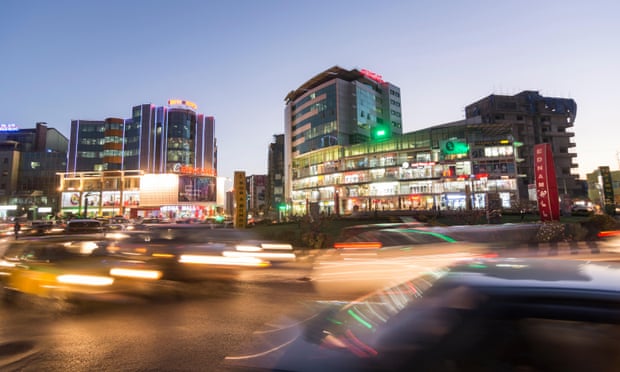
The hulking waste-to-energy power plant taking shape on the edge of Addis Ababa, Ethiopia’s capital, symbolises ambitions to convert the agrarian Horn of Africa country into an eco-friendly industrial powerhouse.
The government’s $120m (£76.8m) Reppie project, being built to EU emissions standards, will incinerate the city’s rubbish to generate 50MW of electricity. A computer-generated image on display at the site shows the future factory shrouded by a tree-filled park.
In about a year, green, cutting-edge Reppie will replace a vast rubbish dump picked over by hundreds of scavengers. Currently, toxic effluent from the landfill seeps into nearby rivers when it rains and methane perpetually drifts into the atmosphere.
The power plant is just one facet of Ethiopia’s four-year-old climate resilient green economy (CRGE) strategy, which aims for the nation to become middle-income by 2025 while limiting its carbon footprint to less than 2010 levels by 2030.
“In doing this we ensure our development is sustainable, and another thing is we ensure we contribute positively to the global interest,” said the minister of environment and forest, Belete Tafere.
Successful implementation of the plan, formally presented to the UN last month, would mean a reversal of existing trends in a nation that regularly suffers droughts and floods. Ethiopia’s deforested, intensively cultivated highlands are degraded and eroded. The capital has ageing vehicles spewing fumes and a dearth of green public spaces, while its rivers are choked with garbage.
The CRGE initiative has four pillars: renewable energy, modernising agriculture, reforestation and adopting energy-efficient technology. Ethiopia’s hydropower possibilities, in the government’s eyes, resolve the inherent tension in industrialising while trying to curb emissions.
Although Ethiopia produces only 2,300MW of power for 96 million people – compared with the UK’s 110,000MW for a population of 64 million – mountainous terrain and nine river basins give it the potential for 45,000MW from hydropower. Developing dams, while also investing in wind, solar and geothermal energy, should create the ability to power a manufacturing boom without burning fossil fuels.
“We are absolutely going to depend on the renewable resources for our energy development,” Belete said. “Industries are going to use only energy from the grid that is renewable.”
An initial plank of the CRGE is slotting into place with the imminent completionof the 1,870MW Gibe III hydropower station. Despite Ethiopia’s dire need for power, western pressure groups such as International Rivers are up in arms over the $1.8bn project. They claim it will facilitate large-scale irrigation that will have a devastating impact on up to 500,000 people by drying out Lake Turkana.

The government ramped up its hydropower programme in 2011 by beginning the Grand Ethiopian Renaissance Dam on the Blue Nile. The 6,000MW capacity will make it Africa’s largest power plant.
Tapping into this clean energy, along with factories, will be public transport – including a 5,000km electrified rail network. The government has already used Chinese loans and contractors to build a track to Djibouti’s port from Addis Ababa, as well as a light rail system in the city.
One obvious barrier to achieving all the CRGE goals in a growing but still poor economy is finding the required $150bn investment, Belete admits. A study by the UK’s Overseas Development Institute (ODI) estimated the government’s annual resources to be $440m when $7.5bn a year is needed.
The 2014 ODI study also noted that “considerable investments” are required to ensure the local governments responsible implement the CRGE. The upside is that Ethiopia’s semi-authoritarian system is ideally set up for mobilising communities to engage in activities such as tree planting, as well as water-harvesting projects and constructing terracing to prevent soil erosion.
The finance ministry has set up a CRGE facility to pool donor climate-finance funds, but the level of contributions will depend on how much victims of climate change such as Ethiopia are compensated by the industrialised nations that have caused it.
Full implementation of the plan is “contingent upon an ambitious multilateral agreement being reached among parties that enables Ethiopia to get international support and that stimulates investments”, the government said of forthcoming climate change talks in its UN submission. High-level negotiations resume in Paris in December.
While that process continues, Ethiopia is exploring all options, including private investment. Ken Montler and his US companies Pangea and Global Electric Transport (GET) see commercial opportunity in Ethiopia’s eco-friendly vision. Following a successful venture in the Philippines, Pangea plans to assemble electric buses in the country that will be used in a GET-managed public transport system.

Montler says the Nile megadam and technological leapfrogging to electric trains and vehicles gives Ethiopia a chance of being carbon-neutral in the next decade. “You really have to be electric to hit those kind of numbers,” he said.
Critical for success is the trajectory of agriculture, with livestock emissions of methane and nitrous oxide responsible for 42% of the total in 2010. However, the approach to the sector thatemploys 80% of Ethiopians lacks the coherence of the renewable energy plan.
It hinges partly on boosting productivity by methods such as mechanisation, higher yielding seeds, irrigation, using organic fertilisers and “efficiency improvement to the livestock value chain” – strategies that aren’t a marked departure from decades-old attempts to modernise a sector dominated by subsistence farming on dwindling highland plots and pastoralism in semi-arid areas.
The plan also rests on an assumption that agriculture’s importance will reduce as Ethiopia follows a well-trodden path to prosperity via industrialisation and urbanisation, Belete said. “As the country is moving for transformation, people could have an interest in depending on different livelihoods. Now, they don’t have any other options.”
Source: The Guardian

No comments:
Post a Comment